MKTG1250 Fashion & Trend: Stylish Fashion Retail Industry Analysis
VerifiedAdded on 2023/04/07
|15
|2889
|201
Report
AI Summary
This report analyzes the Australian fashion retail industry, focusing on the establishment of a startup called Stylish Fashion in Melbourne. It examines the industry's size, growth, and key players, including both local and international brands. A macro and meso environment analysis identifies opportunities and threats, particularly focusing on the company's strategy to use festival wear as a unique selling point. The report also isolates the drivers of change in the industry, such as competition and technological advancements, and provides recommendations for Stylish Fashion to capitalize on opportunities and mitigate potential threats. Desklib offers similar reports and study resources for students.

Running head: MANAGEMENT
Management
Name of Student
Name of University
Author Note
Management
Name of Student
Name of University
Author Note
Paraphrase This Document
Need a fresh take? Get an instant paraphrase of this document with our AI Paraphraser
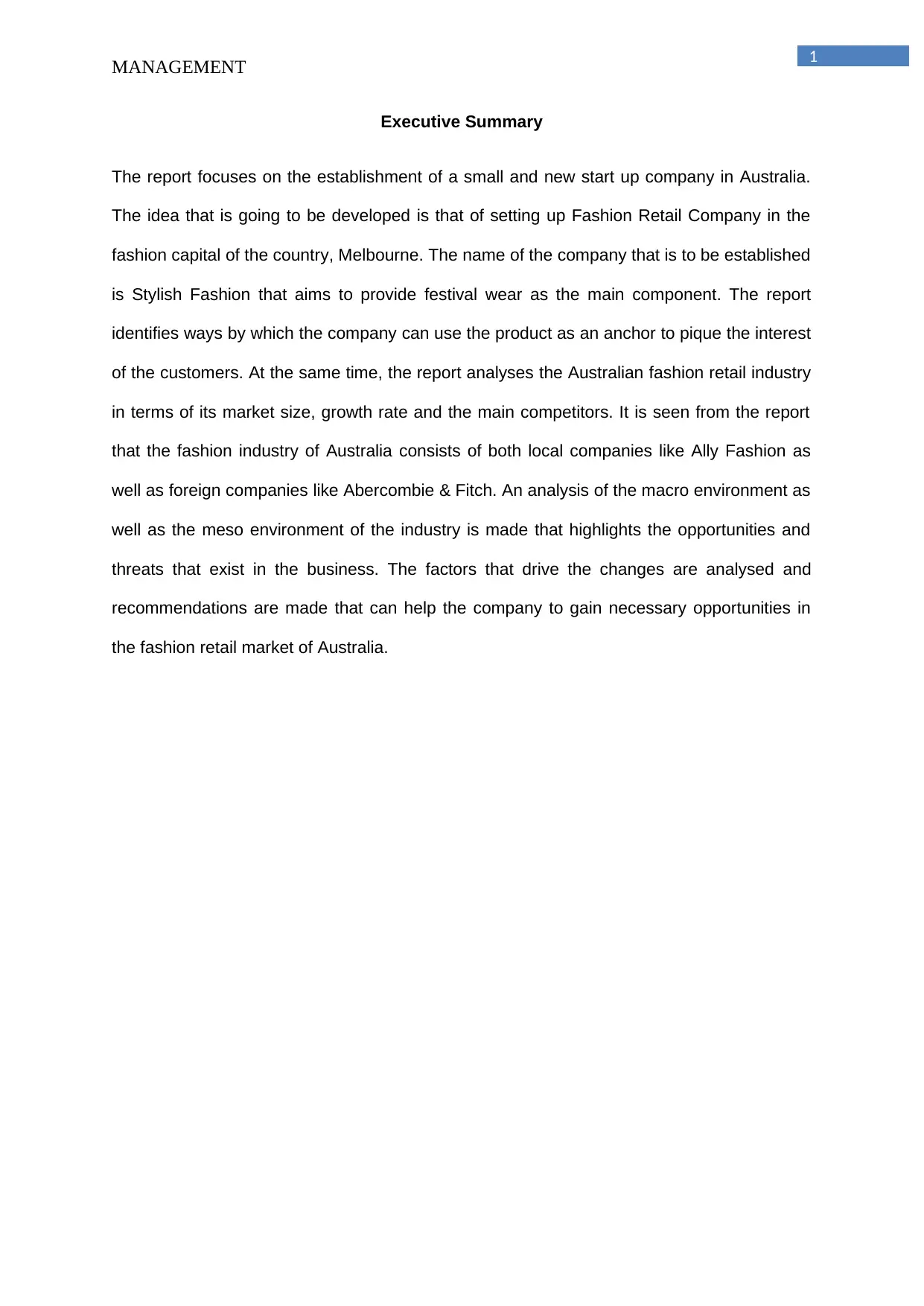
1
MANAGEMENT
Executive Summary
The report focuses on the establishment of a small and new start up company in Australia.
The idea that is going to be developed is that of setting up Fashion Retail Company in the
fashion capital of the country, Melbourne. The name of the company that is to be established
is Stylish Fashion that aims to provide festival wear as the main component. The report
identifies ways by which the company can use the product as an anchor to pique the interest
of the customers. At the same time, the report analyses the Australian fashion retail industry
in terms of its market size, growth rate and the main competitors. It is seen from the report
that the fashion industry of Australia consists of both local companies like Ally Fashion as
well as foreign companies like Abercombie & Fitch. An analysis of the macro environment as
well as the meso environment of the industry is made that highlights the opportunities and
threats that exist in the business. The factors that drive the changes are analysed and
recommendations are made that can help the company to gain necessary opportunities in
the fashion retail market of Australia.
MANAGEMENT
Executive Summary
The report focuses on the establishment of a small and new start up company in Australia.
The idea that is going to be developed is that of setting up Fashion Retail Company in the
fashion capital of the country, Melbourne. The name of the company that is to be established
is Stylish Fashion that aims to provide festival wear as the main component. The report
identifies ways by which the company can use the product as an anchor to pique the interest
of the customers. At the same time, the report analyses the Australian fashion retail industry
in terms of its market size, growth rate and the main competitors. It is seen from the report
that the fashion industry of Australia consists of both local companies like Ally Fashion as
well as foreign companies like Abercombie & Fitch. An analysis of the macro environment as
well as the meso environment of the industry is made that highlights the opportunities and
threats that exist in the business. The factors that drive the changes are analysed and
recommendations are made that can help the company to gain necessary opportunities in
the fashion retail market of Australia.
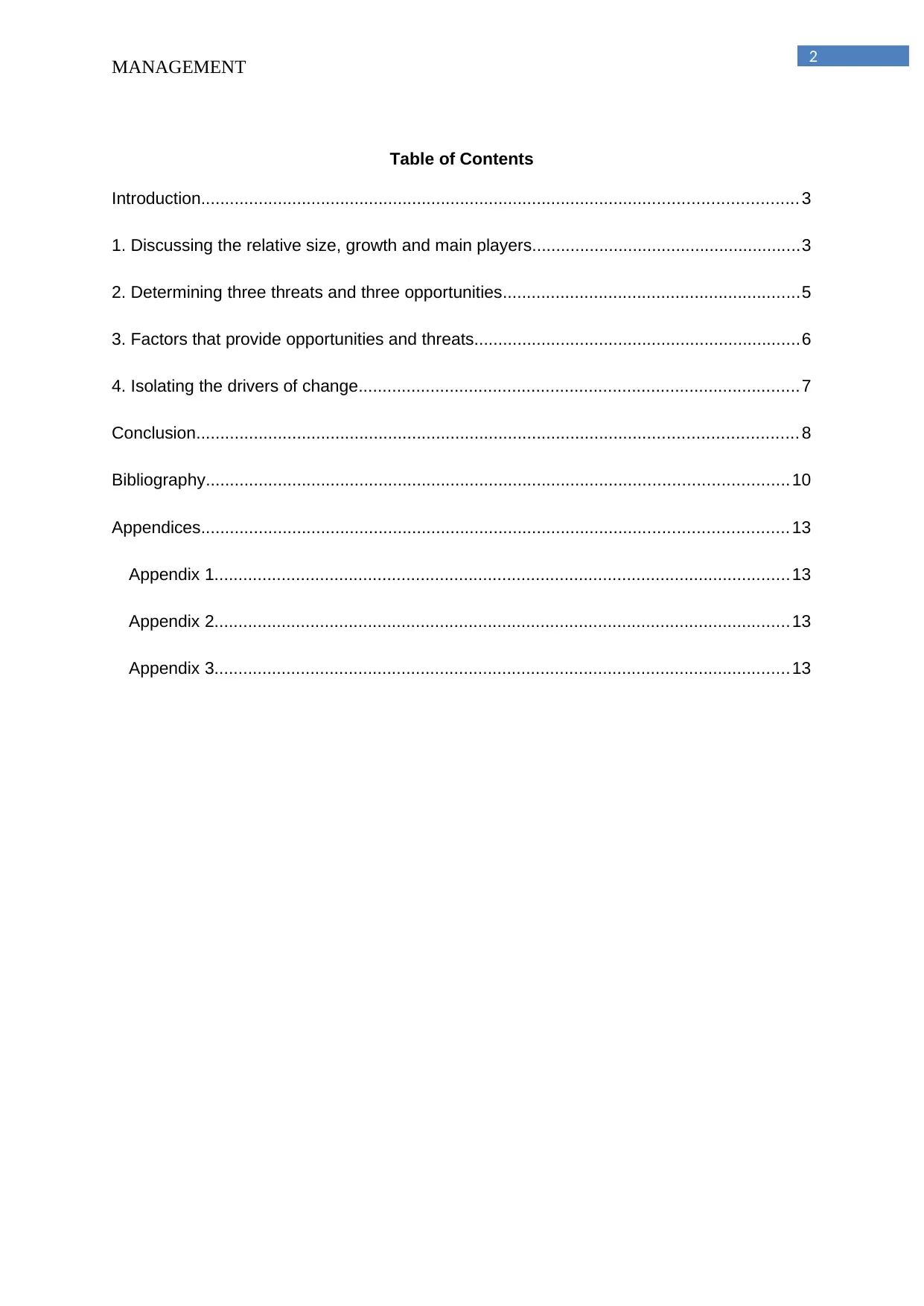
2
MANAGEMENT
Table of Contents
Introduction............................................................................................................................ 3
1. Discussing the relative size, growth and main players........................................................3
2. Determining three threats and three opportunities..............................................................5
3. Factors that provide opportunities and threats....................................................................6
4. Isolating the drivers of change............................................................................................7
Conclusion............................................................................................................................. 8
Bibliography......................................................................................................................... 10
Appendices.......................................................................................................................... 13
Appendix 1........................................................................................................................ 13
Appendix 2........................................................................................................................ 13
Appendix 3........................................................................................................................ 13
MANAGEMENT
Table of Contents
Introduction............................................................................................................................ 3
1. Discussing the relative size, growth and main players........................................................3
2. Determining three threats and three opportunities..............................................................5
3. Factors that provide opportunities and threats....................................................................6
4. Isolating the drivers of change............................................................................................7
Conclusion............................................................................................................................. 8
Bibliography......................................................................................................................... 10
Appendices.......................................................................................................................... 13
Appendix 1........................................................................................................................ 13
Appendix 2........................................................................................................................ 13
Appendix 3........................................................................................................................ 13
⊘ This is a preview!⊘
Do you want full access?
Subscribe today to unlock all pages.

Trusted by 1+ million students worldwide
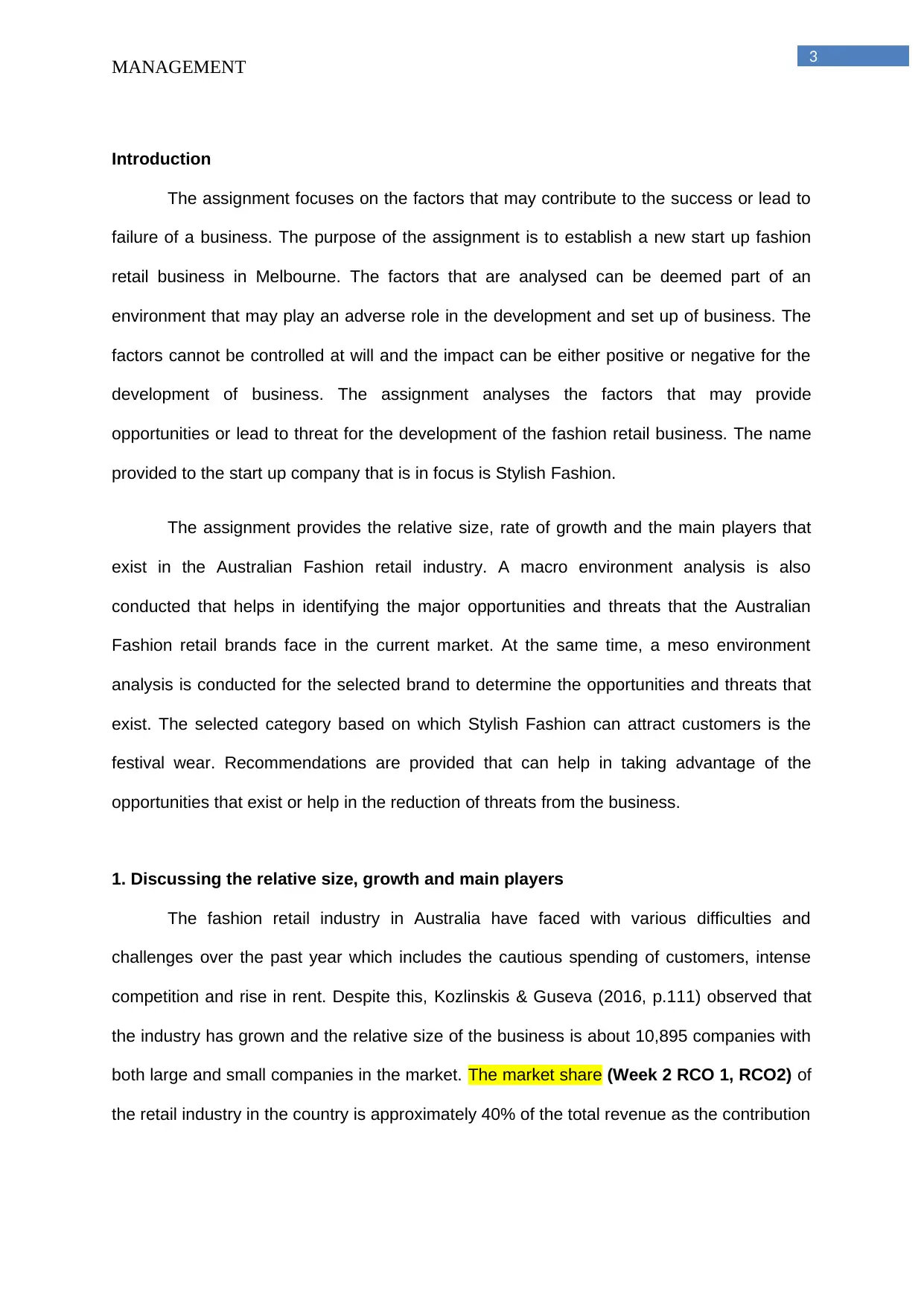
3
MANAGEMENT
Introduction
The assignment focuses on the factors that may contribute to the success or lead to
failure of a business. The purpose of the assignment is to establish a new start up fashion
retail business in Melbourne. The factors that are analysed can be deemed part of an
environment that may play an adverse role in the development and set up of business. The
factors cannot be controlled at will and the impact can be either positive or negative for the
development of business. The assignment analyses the factors that may provide
opportunities or lead to threat for the development of the fashion retail business. The name
provided to the start up company that is in focus is Stylish Fashion.
The assignment provides the relative size, rate of growth and the main players that
exist in the Australian Fashion retail industry. A macro environment analysis is also
conducted that helps in identifying the major opportunities and threats that the Australian
Fashion retail brands face in the current market. At the same time, a meso environment
analysis is conducted for the selected brand to determine the opportunities and threats that
exist. The selected category based on which Stylish Fashion can attract customers is the
festival wear. Recommendations are provided that can help in taking advantage of the
opportunities that exist or help in the reduction of threats from the business.
1. Discussing the relative size, growth and main players
The fashion retail industry in Australia have faced with various difficulties and
challenges over the past year which includes the cautious spending of customers, intense
competition and rise in rent. Despite this, Kozlinskis & Guseva (2016, p.111) observed that
the industry has grown and the relative size of the business is about 10,895 companies with
both large and small companies in the market. The market share (Week 2 RCO 1, RCO2) of
the retail industry in the country is approximately 40% of the total revenue as the contribution
MANAGEMENT
Introduction
The assignment focuses on the factors that may contribute to the success or lead to
failure of a business. The purpose of the assignment is to establish a new start up fashion
retail business in Melbourne. The factors that are analysed can be deemed part of an
environment that may play an adverse role in the development and set up of business. The
factors cannot be controlled at will and the impact can be either positive or negative for the
development of business. The assignment analyses the factors that may provide
opportunities or lead to threat for the development of the fashion retail business. The name
provided to the start up company that is in focus is Stylish Fashion.
The assignment provides the relative size, rate of growth and the main players that
exist in the Australian Fashion retail industry. A macro environment analysis is also
conducted that helps in identifying the major opportunities and threats that the Australian
Fashion retail brands face in the current market. At the same time, a meso environment
analysis is conducted for the selected brand to determine the opportunities and threats that
exist. The selected category based on which Stylish Fashion can attract customers is the
festival wear. Recommendations are provided that can help in taking advantage of the
opportunities that exist or help in the reduction of threats from the business.
1. Discussing the relative size, growth and main players
The fashion retail industry in Australia have faced with various difficulties and
challenges over the past year which includes the cautious spending of customers, intense
competition and rise in rent. Despite this, Kozlinskis & Guseva (2016, p.111) observed that
the industry has grown and the relative size of the business is about 10,895 companies with
both large and small companies in the market. The market share (Week 2 RCO 1, RCO2) of
the retail industry in the country is approximately 40% of the total revenue as the contribution
Paraphrase This Document
Need a fresh take? Get an instant paraphrase of this document with our AI Paraphraser

4
MANAGEMENT
is mainly from foreign countries (Ibisworld.com.au 2019). The figure highlights the major
contributors of the Australian retail industry.
Figure 1: Major contributors of the Australian fashion industry
(Source: Ibisworld.com.au 2019)
As seen from the figure the US, invest more in the Australian fashion industry with
other countries trying to gain recognition in the market. As such, the rate of growth of the
industry is attributed to 2.1% per year starting from 2014 until the present day
(Ibisworld.com.au 2019). It also provides employment to 109,957 people. (Ibisworld.com.au
2019) In this regard, an analysis can be made about the major players that exist in the
industry so that Stylish Fashion can gain opportunity in the business. As seen from the figure
provided, the US is the major investors in the Australian fashion industry and it is for this
reason that reputed US companies like Abercombie & Fitch, Banana Republic and J. Crew
have managed to establish its existence in the industry.
At the same time, Australian base companies such as Ally Fashion, Billabong,
Calibre and The Iconic are some of the biggest names in the Australian fashion retail
industry. The competition that Stylish Fashion may face in Melbourne can be from Driza-
Bone, Sting Sports and Tarocash as these companies are reputed to provide regular
MANAGEMENT
is mainly from foreign countries (Ibisworld.com.au 2019). The figure highlights the major
contributors of the Australian retail industry.
Figure 1: Major contributors of the Australian fashion industry
(Source: Ibisworld.com.au 2019)
As seen from the figure the US, invest more in the Australian fashion industry with
other countries trying to gain recognition in the market. As such, the rate of growth of the
industry is attributed to 2.1% per year starting from 2014 until the present day
(Ibisworld.com.au 2019). It also provides employment to 109,957 people. (Ibisworld.com.au
2019) In this regard, an analysis can be made about the major players that exist in the
industry so that Stylish Fashion can gain opportunity in the business. As seen from the figure
provided, the US is the major investors in the Australian fashion industry and it is for this
reason that reputed US companies like Abercombie & Fitch, Banana Republic and J. Crew
have managed to establish its existence in the industry.
At the same time, Australian base companies such as Ally Fashion, Billabong,
Calibre and The Iconic are some of the biggest names in the Australian fashion retail
industry. The competition that Stylish Fashion may face in Melbourne can be from Driza-
Bone, Sting Sports and Tarocash as these companies are reputed to provide regular
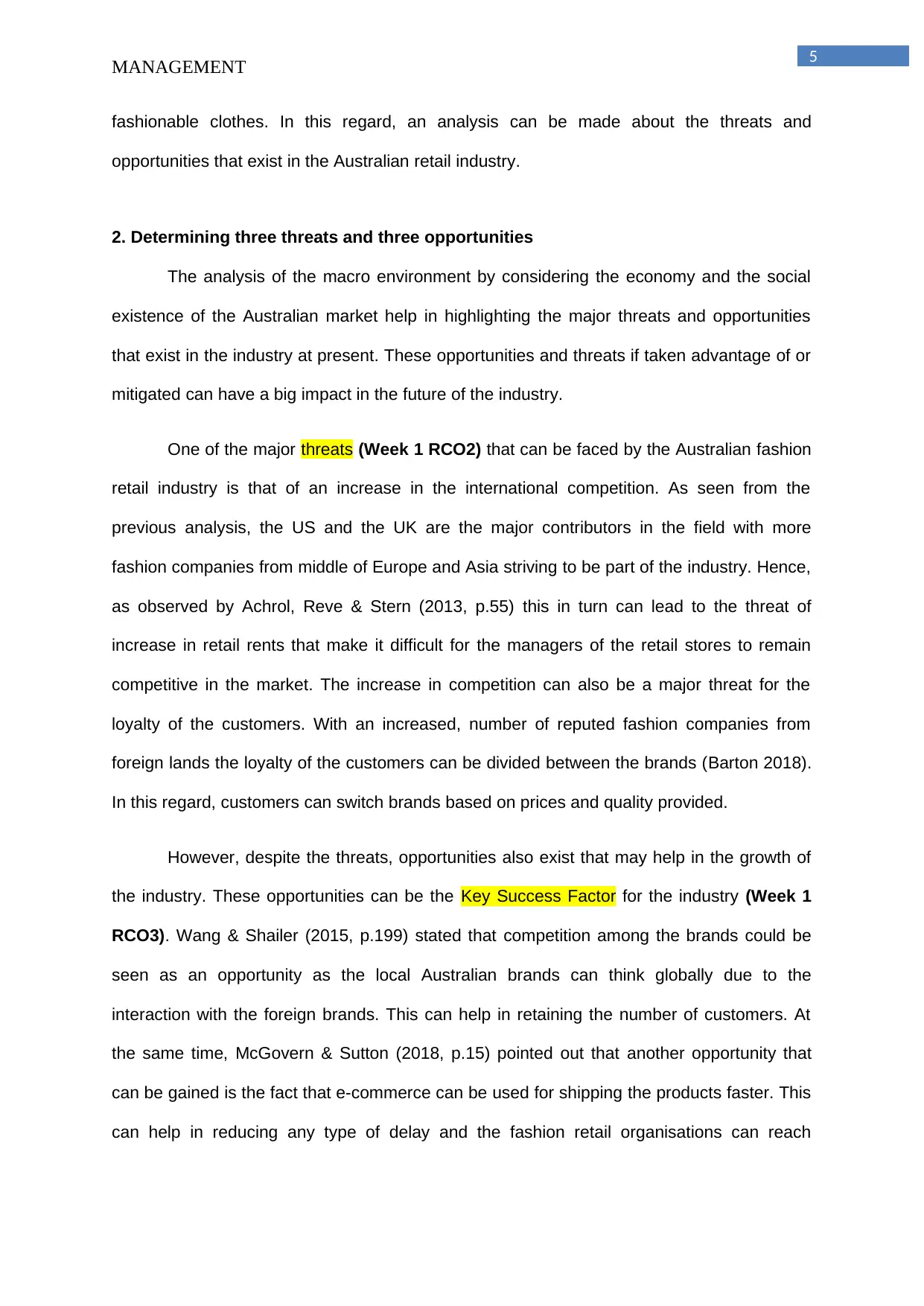
5
MANAGEMENT
fashionable clothes. In this regard, an analysis can be made about the threats and
opportunities that exist in the Australian retail industry.
2. Determining three threats and three opportunities
The analysis of the macro environment by considering the economy and the social
existence of the Australian market help in highlighting the major threats and opportunities
that exist in the industry at present. These opportunities and threats if taken advantage of or
mitigated can have a big impact in the future of the industry.
One of the major threats (Week 1 RCO2) that can be faced by the Australian fashion
retail industry is that of an increase in the international competition. As seen from the
previous analysis, the US and the UK are the major contributors in the field with more
fashion companies from middle of Europe and Asia striving to be part of the industry. Hence,
as observed by Achrol, Reve & Stern (2013, p.55) this in turn can lead to the threat of
increase in retail rents that make it difficult for the managers of the retail stores to remain
competitive in the market. The increase in competition can also be a major threat for the
loyalty of the customers. With an increased, number of reputed fashion companies from
foreign lands the loyalty of the customers can be divided between the brands (Barton 2018).
In this regard, customers can switch brands based on prices and quality provided.
However, despite the threats, opportunities also exist that may help in the growth of
the industry. These opportunities can be the Key Success Factor for the industry (Week 1
RCO3). Wang & Shailer (2015, p.199) stated that competition among the brands could be
seen as an opportunity as the local Australian brands can think globally due to the
interaction with the foreign brands. This can help in retaining the number of customers. At
the same time, McGovern & Sutton (2018, p.15) pointed out that another opportunity that
can be gained is the fact that e-commerce can be used for shipping the products faster. This
can help in reducing any type of delay and the fashion retail organisations can reach
MANAGEMENT
fashionable clothes. In this regard, an analysis can be made about the threats and
opportunities that exist in the Australian retail industry.
2. Determining three threats and three opportunities
The analysis of the macro environment by considering the economy and the social
existence of the Australian market help in highlighting the major threats and opportunities
that exist in the industry at present. These opportunities and threats if taken advantage of or
mitigated can have a big impact in the future of the industry.
One of the major threats (Week 1 RCO2) that can be faced by the Australian fashion
retail industry is that of an increase in the international competition. As seen from the
previous analysis, the US and the UK are the major contributors in the field with more
fashion companies from middle of Europe and Asia striving to be part of the industry. Hence,
as observed by Achrol, Reve & Stern (2013, p.55) this in turn can lead to the threat of
increase in retail rents that make it difficult for the managers of the retail stores to remain
competitive in the market. The increase in competition can also be a major threat for the
loyalty of the customers. With an increased, number of reputed fashion companies from
foreign lands the loyalty of the customers can be divided between the brands (Barton 2018).
In this regard, customers can switch brands based on prices and quality provided.
However, despite the threats, opportunities also exist that may help in the growth of
the industry. These opportunities can be the Key Success Factor for the industry (Week 1
RCO3). Wang & Shailer (2015, p.199) stated that competition among the brands could be
seen as an opportunity as the local Australian brands can think globally due to the
interaction with the foreign brands. This can help in retaining the number of customers. At
the same time, McGovern & Sutton (2018, p.15) pointed out that another opportunity that
can be gained is the fact that e-commerce can be used for shipping the products faster. This
can help in reducing any type of delay and the fashion retail organisations can reach
⊘ This is a preview!⊘
Do you want full access?
Subscribe today to unlock all pages.

Trusted by 1+ million students worldwide
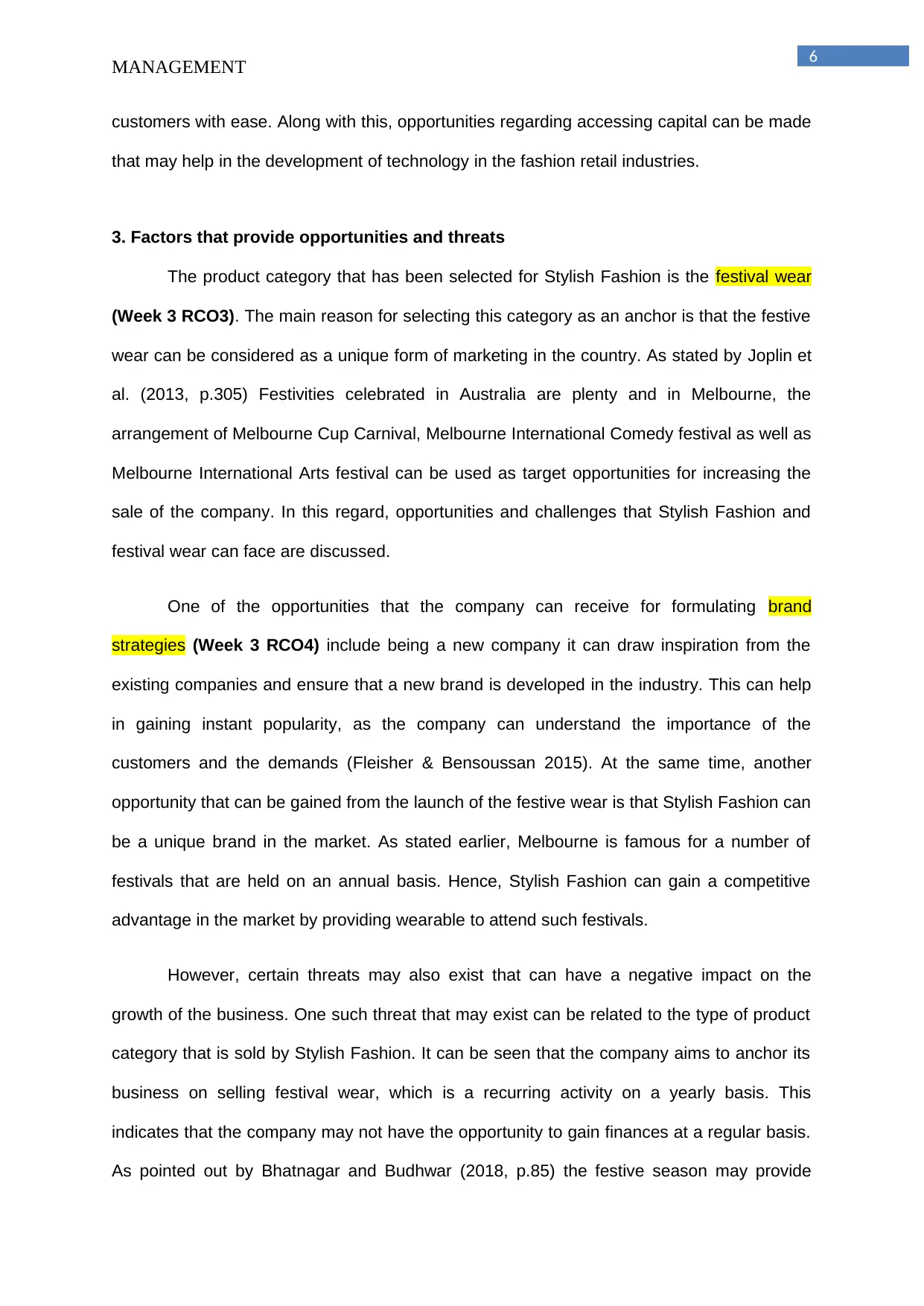
6
MANAGEMENT
customers with ease. Along with this, opportunities regarding accessing capital can be made
that may help in the development of technology in the fashion retail industries.
3. Factors that provide opportunities and threats
The product category that has been selected for Stylish Fashion is the festival wear
(Week 3 RCO3). The main reason for selecting this category as an anchor is that the festive
wear can be considered as a unique form of marketing in the country. As stated by Joplin et
al. (2013, p.305) Festivities celebrated in Australia are plenty and in Melbourne, the
arrangement of Melbourne Cup Carnival, Melbourne International Comedy festival as well as
Melbourne International Arts festival can be used as target opportunities for increasing the
sale of the company. In this regard, opportunities and challenges that Stylish Fashion and
festival wear can face are discussed.
One of the opportunities that the company can receive for formulating brand
strategies (Week 3 RCO4) include being a new company it can draw inspiration from the
existing companies and ensure that a new brand is developed in the industry. This can help
in gaining instant popularity, as the company can understand the importance of the
customers and the demands (Fleisher & Bensoussan 2015). At the same time, another
opportunity that can be gained from the launch of the festive wear is that Stylish Fashion can
be a unique brand in the market. As stated earlier, Melbourne is famous for a number of
festivals that are held on an annual basis. Hence, Stylish Fashion can gain a competitive
advantage in the market by providing wearable to attend such festivals.
However, certain threats may also exist that can have a negative impact on the
growth of the business. One such threat that may exist can be related to the type of product
category that is sold by Stylish Fashion. It can be seen that the company aims to anchor its
business on selling festival wear, which is a recurring activity on a yearly basis. This
indicates that the company may not have the opportunity to gain finances at a regular basis.
As pointed out by Bhatnagar and Budhwar (2018, p.85) the festive season may provide
MANAGEMENT
customers with ease. Along with this, opportunities regarding accessing capital can be made
that may help in the development of technology in the fashion retail industries.
3. Factors that provide opportunities and threats
The product category that has been selected for Stylish Fashion is the festival wear
(Week 3 RCO3). The main reason for selecting this category as an anchor is that the festive
wear can be considered as a unique form of marketing in the country. As stated by Joplin et
al. (2013, p.305) Festivities celebrated in Australia are plenty and in Melbourne, the
arrangement of Melbourne Cup Carnival, Melbourne International Comedy festival as well as
Melbourne International Arts festival can be used as target opportunities for increasing the
sale of the company. In this regard, opportunities and challenges that Stylish Fashion and
festival wear can face are discussed.
One of the opportunities that the company can receive for formulating brand
strategies (Week 3 RCO4) include being a new company it can draw inspiration from the
existing companies and ensure that a new brand is developed in the industry. This can help
in gaining instant popularity, as the company can understand the importance of the
customers and the demands (Fleisher & Bensoussan 2015). At the same time, another
opportunity that can be gained from the launch of the festive wear is that Stylish Fashion can
be a unique brand in the market. As stated earlier, Melbourne is famous for a number of
festivals that are held on an annual basis. Hence, Stylish Fashion can gain a competitive
advantage in the market by providing wearable to attend such festivals.
However, certain threats may also exist that can have a negative impact on the
growth of the business. One such threat that may exist can be related to the type of product
category that is sold by Stylish Fashion. It can be seen that the company aims to anchor its
business on selling festival wear, which is a recurring activity on a yearly basis. This
indicates that the company may not have the opportunity to gain finances at a regular basis.
As pointed out by Bhatnagar and Budhwar (2018, p.85) the festive season may provide
Paraphrase This Document
Need a fresh take? Get an instant paraphrase of this document with our AI Paraphraser
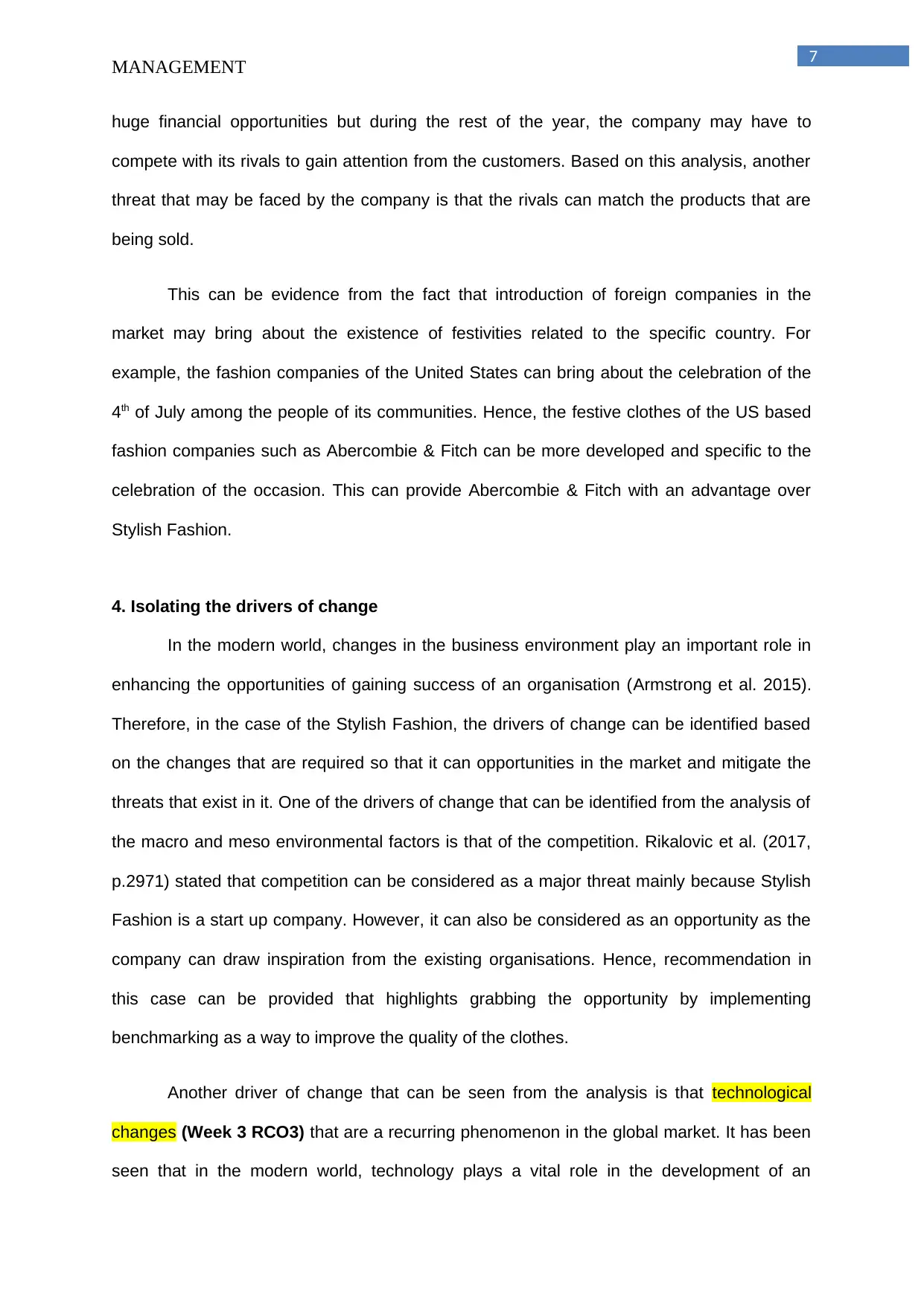
7
MANAGEMENT
huge financial opportunities but during the rest of the year, the company may have to
compete with its rivals to gain attention from the customers. Based on this analysis, another
threat that may be faced by the company is that the rivals can match the products that are
being sold.
This can be evidence from the fact that introduction of foreign companies in the
market may bring about the existence of festivities related to the specific country. For
example, the fashion companies of the United States can bring about the celebration of the
4th of July among the people of its communities. Hence, the festive clothes of the US based
fashion companies such as Abercombie & Fitch can be more developed and specific to the
celebration of the occasion. This can provide Abercombie & Fitch with an advantage over
Stylish Fashion.
4. Isolating the drivers of change
In the modern world, changes in the business environment play an important role in
enhancing the opportunities of gaining success of an organisation (Armstrong et al. 2015).
Therefore, in the case of the Stylish Fashion, the drivers of change can be identified based
on the changes that are required so that it can opportunities in the market and mitigate the
threats that exist in it. One of the drivers of change that can be identified from the analysis of
the macro and meso environmental factors is that of the competition. Rikalovic et al. (2017,
p.2971) stated that competition can be considered as a major threat mainly because Stylish
Fashion is a start up company. However, it can also be considered as an opportunity as the
company can draw inspiration from the existing organisations. Hence, recommendation in
this case can be provided that highlights grabbing the opportunity by implementing
benchmarking as a way to improve the quality of the clothes.
Another driver of change that can be seen from the analysis is that technological
changes (Week 3 RCO3) that are a recurring phenomenon in the global market. It has been
seen that in the modern world, technology plays a vital role in the development of an
MANAGEMENT
huge financial opportunities but during the rest of the year, the company may have to
compete with its rivals to gain attention from the customers. Based on this analysis, another
threat that may be faced by the company is that the rivals can match the products that are
being sold.
This can be evidence from the fact that introduction of foreign companies in the
market may bring about the existence of festivities related to the specific country. For
example, the fashion companies of the United States can bring about the celebration of the
4th of July among the people of its communities. Hence, the festive clothes of the US based
fashion companies such as Abercombie & Fitch can be more developed and specific to the
celebration of the occasion. This can provide Abercombie & Fitch with an advantage over
Stylish Fashion.
4. Isolating the drivers of change
In the modern world, changes in the business environment play an important role in
enhancing the opportunities of gaining success of an organisation (Armstrong et al. 2015).
Therefore, in the case of the Stylish Fashion, the drivers of change can be identified based
on the changes that are required so that it can opportunities in the market and mitigate the
threats that exist in it. One of the drivers of change that can be identified from the analysis of
the macro and meso environmental factors is that of the competition. Rikalovic et al. (2017,
p.2971) stated that competition can be considered as a major threat mainly because Stylish
Fashion is a start up company. However, it can also be considered as an opportunity as the
company can draw inspiration from the existing organisations. Hence, recommendation in
this case can be provided that highlights grabbing the opportunity by implementing
benchmarking as a way to improve the quality of the clothes.
Another driver of change that can be seen from the analysis is that technological
changes (Week 3 RCO3) that are a recurring phenomenon in the global market. It has been
seen that in the modern world, technology plays a vital role in the development of an
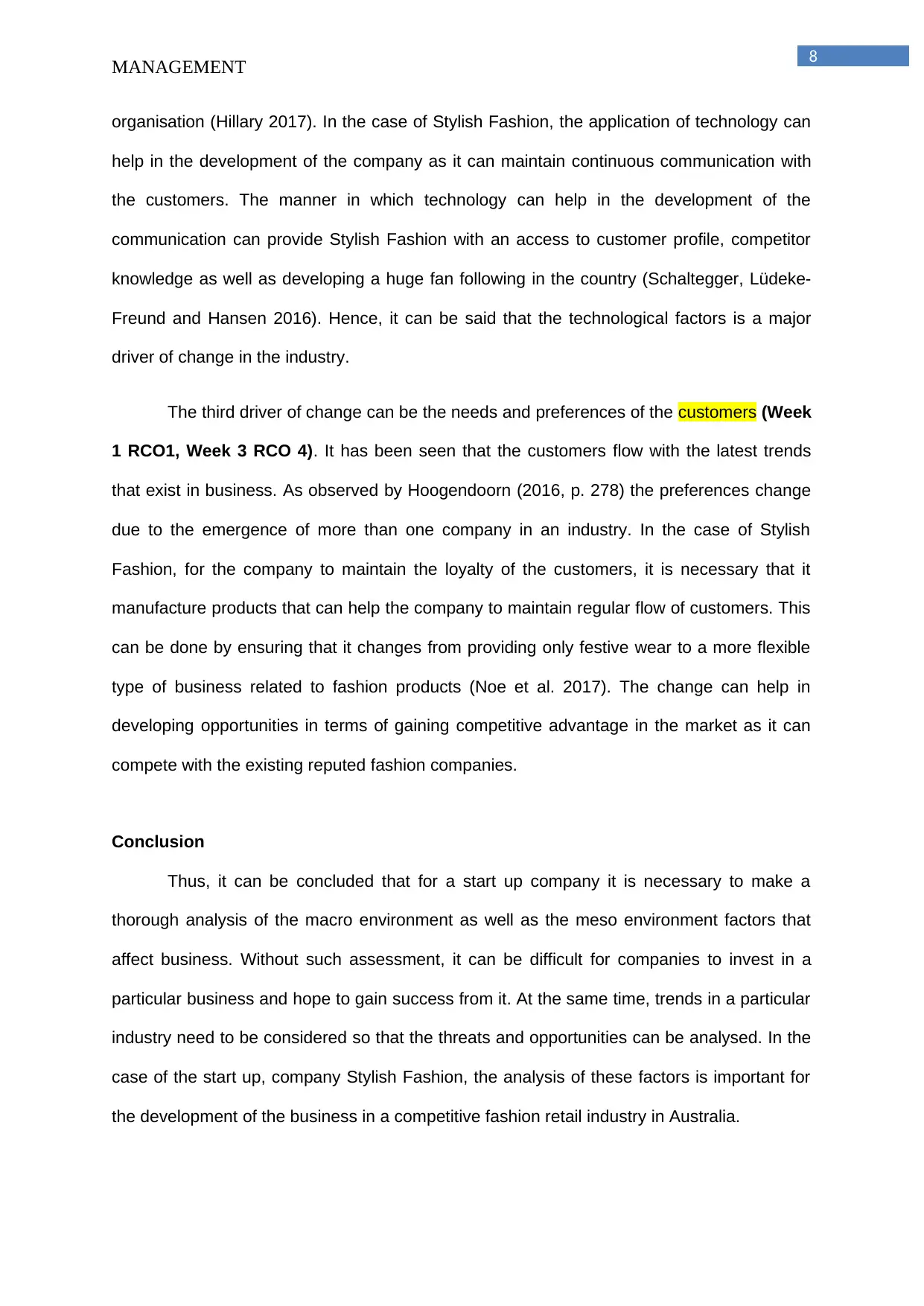
8
MANAGEMENT
organisation (Hillary 2017). In the case of Stylish Fashion, the application of technology can
help in the development of the company as it can maintain continuous communication with
the customers. The manner in which technology can help in the development of the
communication can provide Stylish Fashion with an access to customer profile, competitor
knowledge as well as developing a huge fan following in the country (Schaltegger, Lüdeke-
Freund and Hansen 2016). Hence, it can be said that the technological factors is a major
driver of change in the industry.
The third driver of change can be the needs and preferences of the customers (Week
1 RCO1, Week 3 RCO 4). It has been seen that the customers flow with the latest trends
that exist in business. As observed by Hoogendoorn (2016, p. 278) the preferences change
due to the emergence of more than one company in an industry. In the case of Stylish
Fashion, for the company to maintain the loyalty of the customers, it is necessary that it
manufacture products that can help the company to maintain regular flow of customers. This
can be done by ensuring that it changes from providing only festive wear to a more flexible
type of business related to fashion products (Noe et al. 2017). The change can help in
developing opportunities in terms of gaining competitive advantage in the market as it can
compete with the existing reputed fashion companies.
Conclusion
Thus, it can be concluded that for a start up company it is necessary to make a
thorough analysis of the macro environment as well as the meso environment factors that
affect business. Without such assessment, it can be difficult for companies to invest in a
particular business and hope to gain success from it. At the same time, trends in a particular
industry need to be considered so that the threats and opportunities can be analysed. In the
case of the start up, company Stylish Fashion, the analysis of these factors is important for
the development of the business in a competitive fashion retail industry in Australia.
MANAGEMENT
organisation (Hillary 2017). In the case of Stylish Fashion, the application of technology can
help in the development of the company as it can maintain continuous communication with
the customers. The manner in which technology can help in the development of the
communication can provide Stylish Fashion with an access to customer profile, competitor
knowledge as well as developing a huge fan following in the country (Schaltegger, Lüdeke-
Freund and Hansen 2016). Hence, it can be said that the technological factors is a major
driver of change in the industry.
The third driver of change can be the needs and preferences of the customers (Week
1 RCO1, Week 3 RCO 4). It has been seen that the customers flow with the latest trends
that exist in business. As observed by Hoogendoorn (2016, p. 278) the preferences change
due to the emergence of more than one company in an industry. In the case of Stylish
Fashion, for the company to maintain the loyalty of the customers, it is necessary that it
manufacture products that can help the company to maintain regular flow of customers. This
can be done by ensuring that it changes from providing only festive wear to a more flexible
type of business related to fashion products (Noe et al. 2017). The change can help in
developing opportunities in terms of gaining competitive advantage in the market as it can
compete with the existing reputed fashion companies.
Conclusion
Thus, it can be concluded that for a start up company it is necessary to make a
thorough analysis of the macro environment as well as the meso environment factors that
affect business. Without such assessment, it can be difficult for companies to invest in a
particular business and hope to gain success from it. At the same time, trends in a particular
industry need to be considered so that the threats and opportunities can be analysed. In the
case of the start up, company Stylish Fashion, the analysis of these factors is important for
the development of the business in a competitive fashion retail industry in Australia.
⊘ This is a preview!⊘
Do you want full access?
Subscribe today to unlock all pages.

Trusted by 1+ million students worldwide
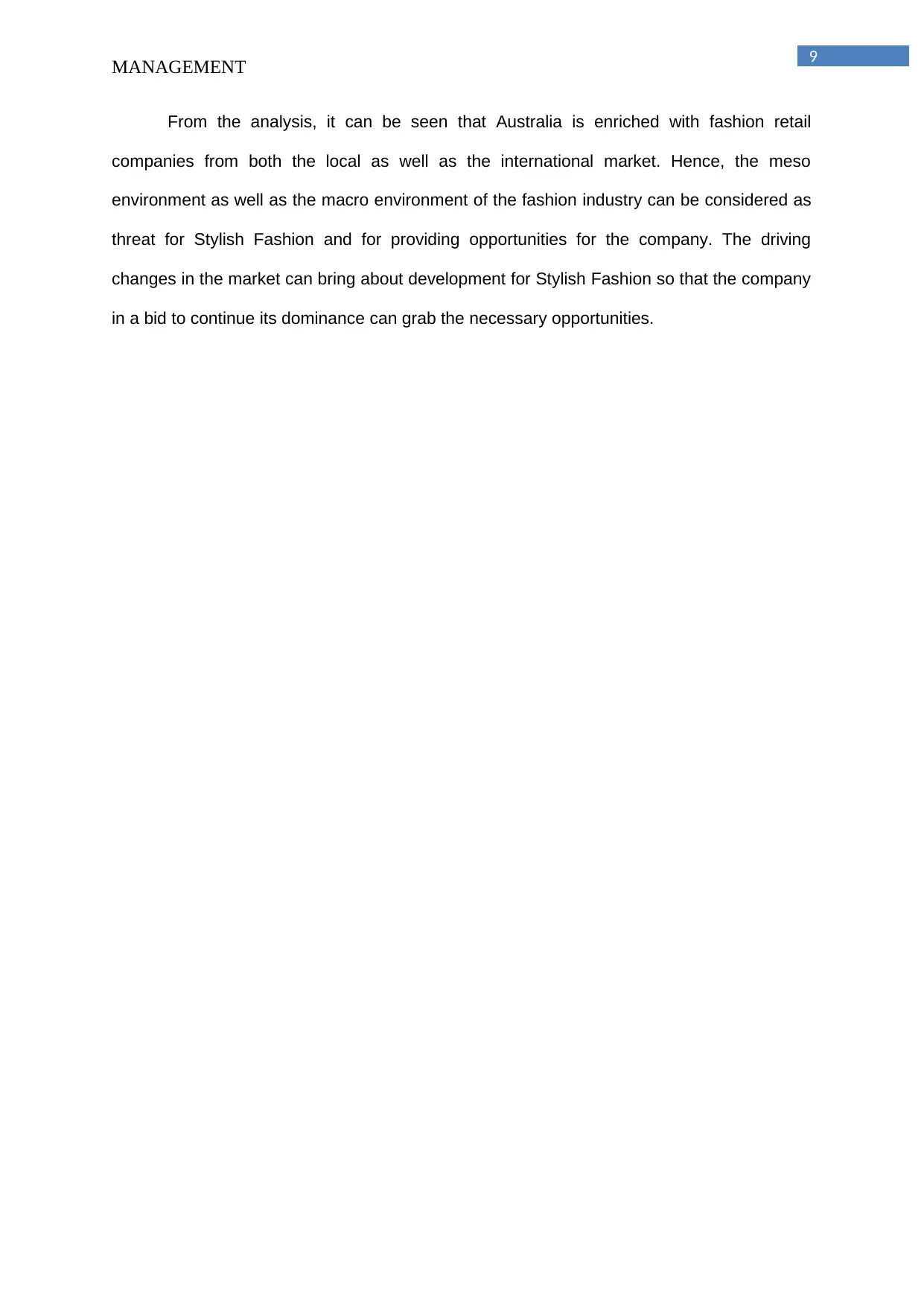
9
MANAGEMENT
From the analysis, it can be seen that Australia is enriched with fashion retail
companies from both the local as well as the international market. Hence, the meso
environment as well as the macro environment of the fashion industry can be considered as
threat for Stylish Fashion and for providing opportunities for the company. The driving
changes in the market can bring about development for Stylish Fashion so that the company
in a bid to continue its dominance can grab the necessary opportunities.
MANAGEMENT
From the analysis, it can be seen that Australia is enriched with fashion retail
companies from both the local as well as the international market. Hence, the meso
environment as well as the macro environment of the fashion industry can be considered as
threat for Stylish Fashion and for providing opportunities for the company. The driving
changes in the market can bring about development for Stylish Fashion so that the company
in a bid to continue its dominance can grab the necessary opportunities.
Paraphrase This Document
Need a fresh take? Get an instant paraphrase of this document with our AI Paraphraser
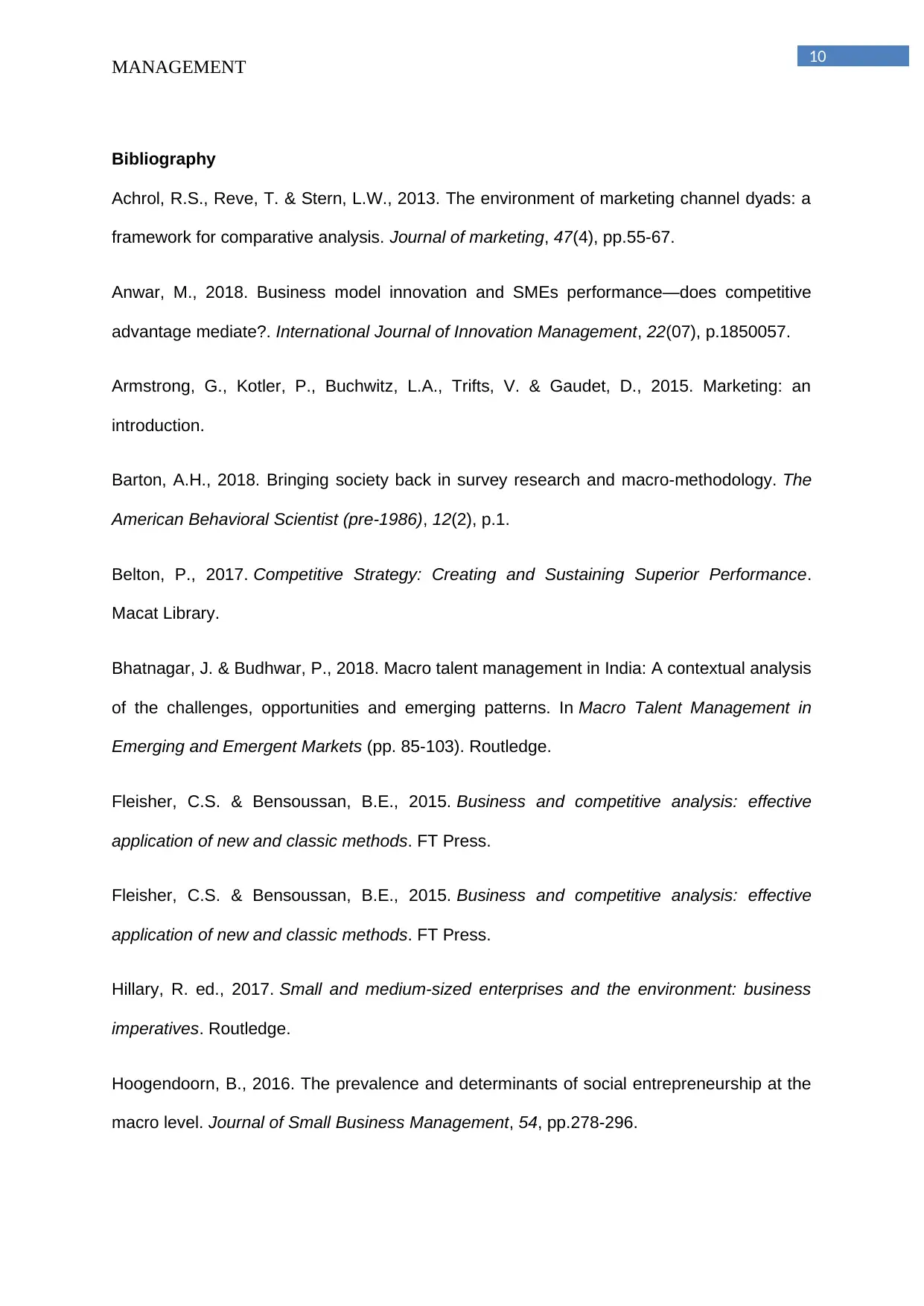
10
MANAGEMENT
Bibliography
Achrol, R.S., Reve, T. & Stern, L.W., 2013. The environment of marketing channel dyads: a
framework for comparative analysis. Journal of marketing, 47(4), pp.55-67.
Anwar, M., 2018. Business model innovation and SMEs performance—does competitive
advantage mediate?. International Journal of Innovation Management, 22(07), p.1850057.
Armstrong, G., Kotler, P., Buchwitz, L.A., Trifts, V. & Gaudet, D., 2015. Marketing: an
introduction.
Barton, A.H., 2018. Bringing society back in survey research and macro-methodology. The
American Behavioral Scientist (pre-1986), 12(2), p.1.
Belton, P., 2017. Competitive Strategy: Creating and Sustaining Superior Performance.
Macat Library.
Bhatnagar, J. & Budhwar, P., 2018. Macro talent management in India: A contextual analysis
of the challenges, opportunities and emerging patterns. In Macro Talent Management in
Emerging and Emergent Markets (pp. 85-103). Routledge.
Fleisher, C.S. & Bensoussan, B.E., 2015. Business and competitive analysis: effective
application of new and classic methods. FT Press.
Fleisher, C.S. & Bensoussan, B.E., 2015. Business and competitive analysis: effective
application of new and classic methods. FT Press.
Hillary, R. ed., 2017. Small and medium-sized enterprises and the environment: business
imperatives. Routledge.
Hoogendoorn, B., 2016. The prevalence and determinants of social entrepreneurship at the
macro level. Journal of Small Business Management, 54, pp.278-296.
MANAGEMENT
Bibliography
Achrol, R.S., Reve, T. & Stern, L.W., 2013. The environment of marketing channel dyads: a
framework for comparative analysis. Journal of marketing, 47(4), pp.55-67.
Anwar, M., 2018. Business model innovation and SMEs performance—does competitive
advantage mediate?. International Journal of Innovation Management, 22(07), p.1850057.
Armstrong, G., Kotler, P., Buchwitz, L.A., Trifts, V. & Gaudet, D., 2015. Marketing: an
introduction.
Barton, A.H., 2018. Bringing society back in survey research and macro-methodology. The
American Behavioral Scientist (pre-1986), 12(2), p.1.
Belton, P., 2017. Competitive Strategy: Creating and Sustaining Superior Performance.
Macat Library.
Bhatnagar, J. & Budhwar, P., 2018. Macro talent management in India: A contextual analysis
of the challenges, opportunities and emerging patterns. In Macro Talent Management in
Emerging and Emergent Markets (pp. 85-103). Routledge.
Fleisher, C.S. & Bensoussan, B.E., 2015. Business and competitive analysis: effective
application of new and classic methods. FT Press.
Fleisher, C.S. & Bensoussan, B.E., 2015. Business and competitive analysis: effective
application of new and classic methods. FT Press.
Hillary, R. ed., 2017. Small and medium-sized enterprises and the environment: business
imperatives. Routledge.
Hoogendoorn, B., 2016. The prevalence and determinants of social entrepreneurship at the
macro level. Journal of Small Business Management, 54, pp.278-296.
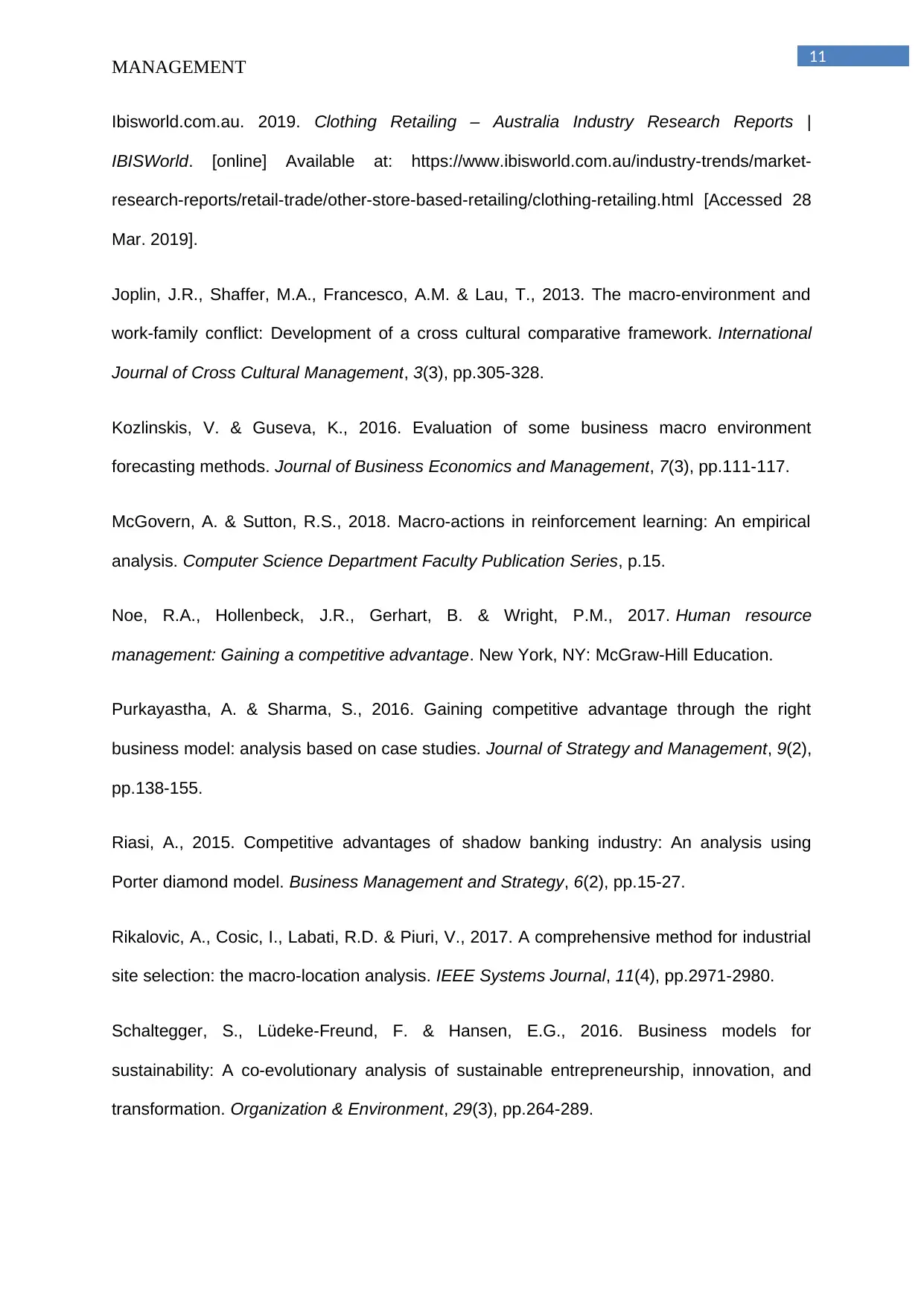
11
MANAGEMENT
Ibisworld.com.au. 2019. Clothing Retailing – Australia Industry Research Reports |
IBISWorld. [online] Available at: https://www.ibisworld.com.au/industry-trends/market-
research-reports/retail-trade/other-store-based-retailing/clothing-retailing.html [Accessed 28
Mar. 2019].
Joplin, J.R., Shaffer, M.A., Francesco, A.M. & Lau, T., 2013. The macro-environment and
work-family conflict: Development of a cross cultural comparative framework. International
Journal of Cross Cultural Management, 3(3), pp.305-328.
Kozlinskis, V. & Guseva, K., 2016. Evaluation of some business macro environment
forecasting methods. Journal of Business Economics and Management, 7(3), pp.111-117.
McGovern, A. & Sutton, R.S., 2018. Macro-actions in reinforcement learning: An empirical
analysis. Computer Science Department Faculty Publication Series, p.15.
Noe, R.A., Hollenbeck, J.R., Gerhart, B. & Wright, P.M., 2017. Human resource
management: Gaining a competitive advantage. New York, NY: McGraw-Hill Education.
Purkayastha, A. & Sharma, S., 2016. Gaining competitive advantage through the right
business model: analysis based on case studies. Journal of Strategy and Management, 9(2),
pp.138-155.
Riasi, A., 2015. Competitive advantages of shadow banking industry: An analysis using
Porter diamond model. Business Management and Strategy, 6(2), pp.15-27.
Rikalovic, A., Cosic, I., Labati, R.D. & Piuri, V., 2017. A comprehensive method for industrial
site selection: the macro-location analysis. IEEE Systems Journal, 11(4), pp.2971-2980.
Schaltegger, S., Lüdeke-Freund, F. & Hansen, E.G., 2016. Business models for
sustainability: A co-evolutionary analysis of sustainable entrepreneurship, innovation, and
transformation. Organization & Environment, 29(3), pp.264-289.
MANAGEMENT
Ibisworld.com.au. 2019. Clothing Retailing – Australia Industry Research Reports |
IBISWorld. [online] Available at: https://www.ibisworld.com.au/industry-trends/market-
research-reports/retail-trade/other-store-based-retailing/clothing-retailing.html [Accessed 28
Mar. 2019].
Joplin, J.R., Shaffer, M.A., Francesco, A.M. & Lau, T., 2013. The macro-environment and
work-family conflict: Development of a cross cultural comparative framework. International
Journal of Cross Cultural Management, 3(3), pp.305-328.
Kozlinskis, V. & Guseva, K., 2016. Evaluation of some business macro environment
forecasting methods. Journal of Business Economics and Management, 7(3), pp.111-117.
McGovern, A. & Sutton, R.S., 2018. Macro-actions in reinforcement learning: An empirical
analysis. Computer Science Department Faculty Publication Series, p.15.
Noe, R.A., Hollenbeck, J.R., Gerhart, B. & Wright, P.M., 2017. Human resource
management: Gaining a competitive advantage. New York, NY: McGraw-Hill Education.
Purkayastha, A. & Sharma, S., 2016. Gaining competitive advantage through the right
business model: analysis based on case studies. Journal of Strategy and Management, 9(2),
pp.138-155.
Riasi, A., 2015. Competitive advantages of shadow banking industry: An analysis using
Porter diamond model. Business Management and Strategy, 6(2), pp.15-27.
Rikalovic, A., Cosic, I., Labati, R.D. & Piuri, V., 2017. A comprehensive method for industrial
site selection: the macro-location analysis. IEEE Systems Journal, 11(4), pp.2971-2980.
Schaltegger, S., Lüdeke-Freund, F. & Hansen, E.G., 2016. Business models for
sustainability: A co-evolutionary analysis of sustainable entrepreneurship, innovation, and
transformation. Organization & Environment, 29(3), pp.264-289.
⊘ This is a preview!⊘
Do you want full access?
Subscribe today to unlock all pages.

Trusted by 1+ million students worldwide
1 out of 15
Related Documents
Your All-in-One AI-Powered Toolkit for Academic Success.
+13062052269
info@desklib.com
Available 24*7 on WhatsApp / Email
![[object Object]](/_next/static/media/star-bottom.7253800d.svg)
Unlock your academic potential
Copyright © 2020–2025 A2Z Services. All Rights Reserved. Developed and managed by ZUCOL.





